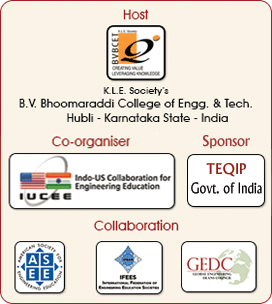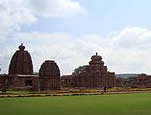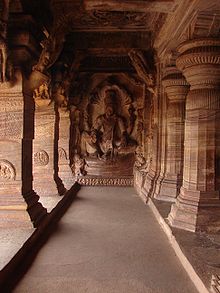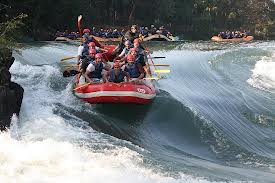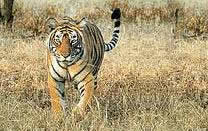Sharing Best Practices of Transformations in Learning Outcomes at Engineering Institutions |
Tourist Places
| PACKAGE 1: HAMPI ( ONE DAY PACKAGE) | ||||||||||||||||
Hampi (Kannada: ಹಂಪೆ Hampe) is a village in northern Karnataka state, India. It is located within the ruins of Vijayanagara, the former capital of the Vijayanagara Empire. Predating the city of Vijayanagara, it continues to be an important religious centre, housing the Virupaksha Temple, as well as several other monuments belonging to the old city. The ruins are a UNESCO World Heritage Site, listed as the Group of Monuments at Hampi. The name is derived from Pampa, which is the old name of the Tungabhadra River on whose banks the city is built. The name "Hampi" is ananglicized version of the Kannada Hampe (derived from Pampa). Over the years, it has also been referred to as Vijayanagara and Virupakshapura (from Virupaksha, the patron deity of the Vijayanagara rulers). Hampi formed one of the core areas of the capital of the Vijayanagara Empire from 1336 to 1565, when it was finally laid siege to by the Deccan Muslim confederacy.Hampi was chosen because of its strategic location, bounded by the torrential Tungabhadra river on one side and surrounded by defensible hills on the other three sides. The site is significant historically and architecturally. The topography abounds with large stones which have been used to make statues of Hindu deities. The Archaeological Survey of India continues to conduct excavations in the area, to discover additional artifacts and temples. Hampi is situated on the banks of the Tungabhadra river. It is 353 km from Bangalore and 74 km away from Bellary. Hosapete (Hospet), 13 km away, is the nearest railway head. Mantralayam, which is also on the banks of Tunghabhadra, in AP is some 150 km away.The principal industries of the village are agriculture, the support of the Virupaksha temple and some other local holy places in the vicinity, and tourism. The annual Vijayanagar Festival is organized by the Government of Karnataka in November |
||||||||||||||||
|
||||||||||||||||
| PACKAGE 2 : PATTADKALL AND CAVE TEMPLES OF BADAMI ( ONE DAY PACKAGE) | ||||||||||||||||
Pattadakal, place for Chalukyas Coronation, the capital of the Chalukya dynasty of Karnataka in Southern India, who built the temples between the 7th and 9th centuries.There are ten temples including a Jain sanctuary surrounded by numerous small shrines and plinths in fusion of various Indian architectural styles (Rekha, Nagara, Prasada and Dravida Vimana). Four temples were built in Chalukya Dravidian style, four in Nagara style of Northern India and the Papanatha temple in mixed style. Nine Shiva temples and one Jaina basadi, situated along the northern course of the River, which is considered as very auspicious according to Holy Scriptures.
|
||||||||||||||||
The Badami cave temples are composed of four caves, all carved out of the soft Badami sandstone on a hill cliff in the late 6th to 7th centuries. The planning of four caves is simple. The entrance is a verandah (mukha mandapa) with stone columns and brackets, a distinctive feature of these caves, leading to a columned mandapa – main hall (also maha mandapa) and then to the small square shrine (sanctum sanctorum, garbhaghrha) cut deep into the cave. The temple caves represent different religious sects. Among them, two (cave 2 and 3) are dedicated to god Vishnu, one to god Shiva (cave 1) and the fourth (cave 4) is a Jain temple. The first three are devoted to the Vedic faith and the fourth cave is the only Jain temple at Badami
|
||||||||||||||||
| PACKAGE 3 : DANDELI WILD LIFE ( ONE DAY PACKAGE) | ||||||||||||||||
Dandeli is a small town in the western ghats of North-West [Karnataka]], India. Dandeli is known as a Wildlife sanctuary and is proud of being one of the tiger projects. People have also moved from across India to work in the industries in Dandeli. Dandeli is also known for its adventure activities on the River Kali. Located close to the Supa Dam on Kali, Dandeli offers options for white water rafting and canoeing. The rapids are class 3 and there is one recirculating rapid in the circuit.
SeeKavala Caves: Ancient Kavala caves are a perfect destination for tourists to visit while their trip to Dandeli. This place is located around at a distance of 25 km from the Dandeli. Tourists will have to trek some thousands steps through a dense forest to reach Kavala caves. These caves are revered as the abode of Lord Shiva-the Hindu god of Destruction. DoDandeli Wild Life Sanctuary and Anshi National Park is dominated by river Kali, be it from its banks or from atop a mountain. The activities at this national park includes: Coracle Rides (in water, would be able to spot crocodiles, hornbills and other birds), Rock Climbing (small), Mountain Biking, Rafting/Kayaking/Canoeing, Camping, Jeep Safari ride, Trekking in the forest, bird watching. Other nearby places to visit includes: Kavala Caves, Syntheri Rocks, Sykes point, Siroli peak.
Delegates interested in tours in North India to places such Delhi, Amritsar, Shimla, Agra, Varanasi, Khajuraho, Jaipur and Rajasthan may contact Nikhil Pandit of TGS Tours & Travels Pvt Ltd (Email - tgsjai@gmail.com, Mobile - +919829963343/+919829063343). TGS can handle hotel bookings, transport and sightseeing arrangements and if required domestic flight and train bookings within India. |
||||||||||||||||
| Latest Announcements | ||
| Conference 16 - 18 January 2014 |
||
